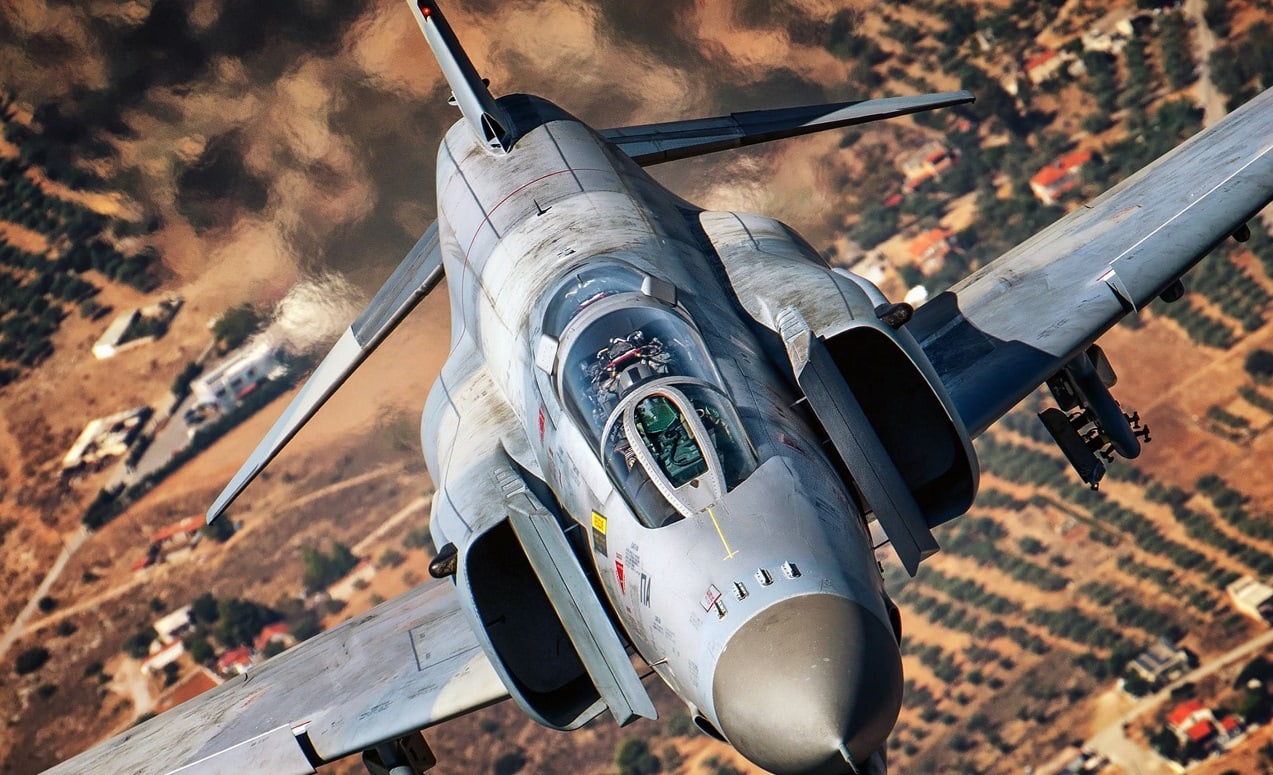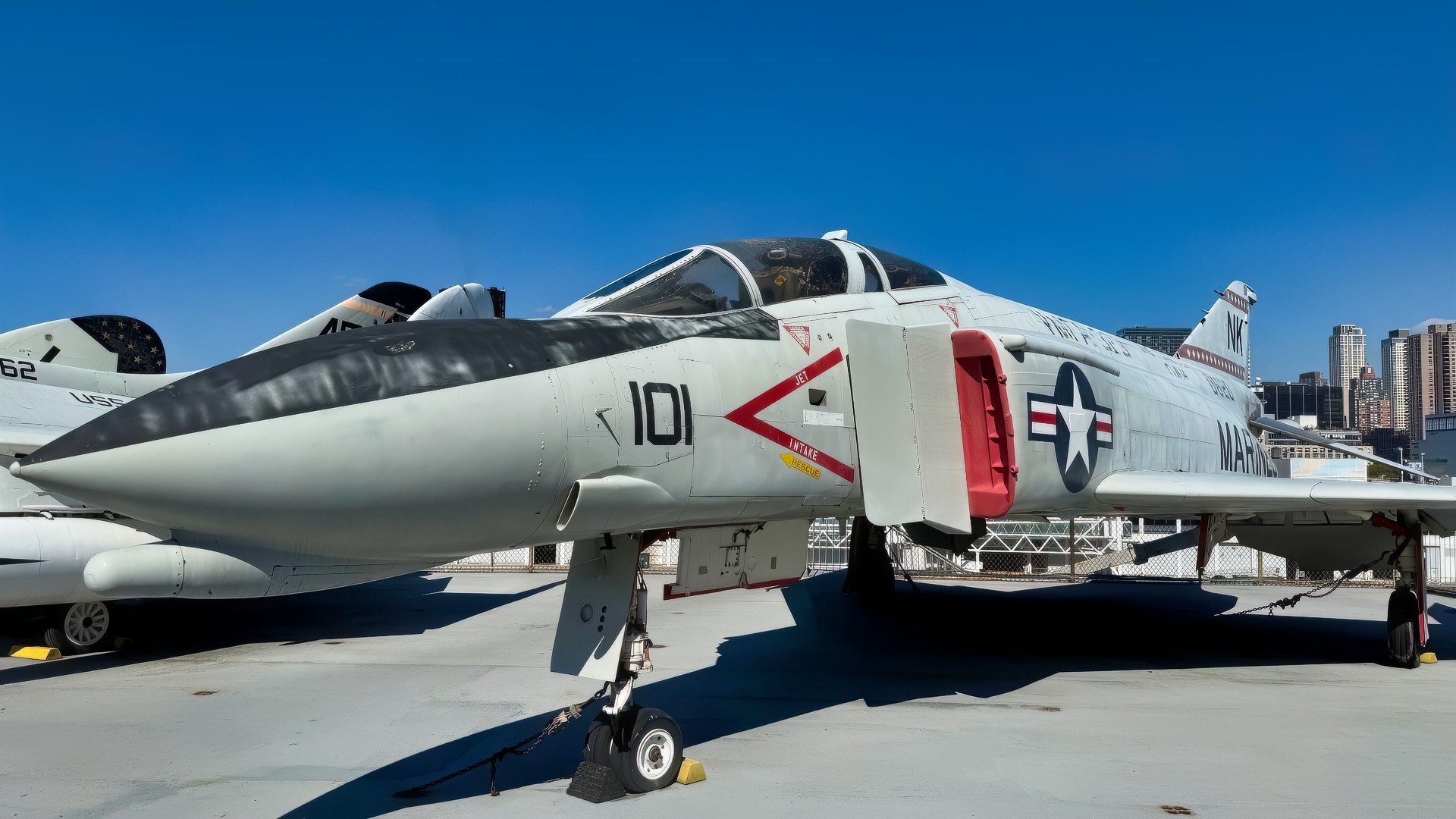Key Points and Summary – Israel’s “Super Phantom” was a deep modernization of the F-4E intended to rival fourth-gen fighters and bridge budget and industrial gaps in the 1980s–90s.
-Phase 1 added new avionics, a Norden/A-6F-derived radar with SAR and look-down/shoot-down, a missile computer, wide-angle display, and extensive rewiring to cut weight.

F-4 Phantom. Image Credit: Creative Commons.

A Fighter Squadron 101 (VF-101) F-4J Phantom II aircraft taxis on the flight deck of the attack aircraft carrier USS AMERICA (CVA 66).
-Phase 2 swapped J79s for Pratt & Whitney PW1120s, lifting thrust-to-weight to 1.04 and improving range and sustained turn.
-Phase 3 added life-extension, larger tank, and intake canards.
-A 1987 Paris demo wowed observers, but U.S. access to cheaper F-16s and the Lavi program undercut the business case; Israel retired Phantoms by 2004.
Meet the F4-E Super Phantom
Two of the most successful American-made fighter jets designed during the Cold War were the McDonnell Douglas F-4 Phantom II and the General Dynamics F-16 Fighting Falcon (the latter is better known to its crews as the “Viper”).
(The F-16, of course, remains in service with the United States and multiple other air forces around the globe, and it’s now built by Lockheed Martin instead of General Dynamics, but that’s a different story.)
Among the foreign military sales (FMS) customers that have successfully used both of these iconic warbirds is the Israeli Air Force (IAF; Zroa HaAvir VeHahalal).
Mind you, the F-4 is a 3rd-generation fighter, while the F-16 is a 4th-generation fighter; yet somehow, the Israelis, being the innovators and improvisers that they are, actually managed to conjure up a version of the former that outperformed the latter.
Say “Shalom” (how apropos, as these words are being typed on Yom Kippur Day) to the F-4E “Super Phantom.”
Basic Premise and Promise of the “Super Phantom”
A top-notch source of information is a 91 August 2021 article by the Military Watch Magazine Editorial Staff, titled “‘Super Phantom’: The Israeli Next Generation F-4 That Could Outperform an F-16.”
As they explain in their opening paragraph: “While Israel initially planned to phase the Phantom out of service in the 1990s, replacing it with a combination of both F-15 Eagles and lighter less costly F-16 Fighting Falcons, economic crisis in the 1980s, extreme inflation rates approaching 30% monthly and an unsustainable defence budget of 24% of GDP meant that compromises to military modernisation plans had to be made. It was thus decided that, following the United States’ refusal to allow Israel to manufacture the F-16 in Israel under licence as Turkey and South Korea were doing, the F-4E would be seriously enhanced to meet fourth-generation standards, allowing it to perform to a much higher standard in both air-to-air combat and in a strike role.”
Necessary Upgrades and Modifications
The enhancements for this “Super Phantom” were divided into two phases.
Phase One:
-Refitted electronics and avionics
-Integration of a Norden radar from the U.S. Navy’s A-6F Intruder II, alongside digital processing and a full look-down/shoot-down capability, would have provided synthetic aperture radar (SAR) mapping and ground target tracking, as well as an air-to-air performance equivalent to the F-16C and a considerably superior air-to-ground performance.
-Installation of a new missile computer, which had already been fitted onto the IAF’s F-16 Soufa (“Storm”) fleet.

F-4 Phantom Images Original National Security Journal.

F-4 Phantom Fighter National Security Journal. Image Taken on August 23, 2025.
-New wide-angle display with a 30-degree horizontal field view
-Removal of old wiring to further cut the overall wire weight by 30%, improving the Phantom’s thrust/weight ratio and thereby positively affecting its flight performance.
Phase Two:
-Replacement of the original Phantom’s J79 turbofan with a Pratt & Whitney PW1120 turbofan – a low-maintenance fourth-generation engine which would provide significantly greater thrust and thus provide the Phantom with very high maneuverability
To put that in numerical perspective, the J79 had a thrust/weight ratio of 0.86 – compared to 1.1 for the F-18 and 1.12 for the F-16.
The PW120 engines not only increased the F-4E’s range but provided a 1.04 thrust/weight ratio and a 27 percent boost to its sustained turn rate at medium altitudes.
Phase Three:
This focused more on life extension than flight performance.
-Structural refurbishments that would add 2,000 hours of service life to each airframe
-Installation of a 2,270L external fuel tank for further increased range
-Addition of canards on the air intakes for better maneuverability
Operational Performance
The Super Phantom made a significant impression at the 1987 Paris Air Show, where its performance was described by analysts as “a startling display of brute power in a series of vertical manoeuvres and tight, high-g turns that were totally out of character for the ageing F-4.”
Had the Super Phantom program been fully implemented, it would have cost an estimated equivalent of $12 million USD per airframe.
It would have reduced the warbirds’ weight by a whopping 680 kilograms (1,499 pounds) while drastically improving their performance across the spectrum.
Alas, despite that impressive performance, the Super Phantom never entered the full production phase or went operational.
Although procuring more indigenous Lavi (“Lion”) jets was more expensive than upgrading existing F-4s, and the Super Phantoms had many performance advantages over the then-new homegrown plane, such as speed and air-to-air performance, Israel needed to expand planned Lavi production to 300-400 specimens for the program to better benefit from economies of scale.
The Lavis also had the advantage of a much longer service life (even when factoring in the Phase Three upgrades to the Phantom).
Furthermore, the State of Israel would subsequently be designated a “strategic ally” of the United States, allowing it to purchase American-made warplanes without incurring research & development costs.
This reduced the cost of acquiring new F-16s and concurrently diminished the appeal of an enhanced F-4. Ergo, the Super Phantom program was cancelled.
(Ironically, the Lavi program was itself terminated in 1987.)
Where Are They Now?
The IAF retired all of its Phantoms, Super and “mere mortal” (so to speak) versions alike, “Kurnass” (Sledgehammer) and RF-4E “Orev” (Raven) variants alike, by 2004. 21 F-4E airframes are preserved for posterity at the Israeli Air Force Museum at Hatzerim Airbase in the Negev Desert; meanwhile, both the IAF Technological College, Beersheba (AKA the Techni School) and the Hedera – Science Park at Givat Olga each have a single F-4E on display.
However, it’s not clear whether any of the surviving Israel Phantoms have the “Super” modifications.
Meanwhile, the legacy of the Super Phantom lives on via relatively inexpensive Phase One upgrades that would later be provided to Turkish Phantoms under the Terminator 2020 program (a transaction that obviously came along during happier days of Israeli-Turkish relations, i.e., before the rule of Turkey’s current iron-fisted and decidedly antisemitic president, Recep Tayyip Erdoğan).
About the Author: Christian D. Orr, Defense Expert
Christian D. Orr is a Senior Defense Editor. He is a former Air Force Security Forces officer, Federal law enforcement officer, and private military contractor (with assignments worked in Iraq, the United Arab Emirates, Kosovo, Japan, Germany, and the Pentagon). Chris holds a B.A. in International Relations from the University of Southern California (USC) and an M.A. in Intelligence Studies (concentration in Terrorism Studies) from American Military University (AMU). He is also the author of the newly published book “Five Decades of a Fabulous Firearm: Celebrating the 50th Anniversary of the Beretta 92 Pistol Series.
More Military
The U.S. Navy’s Great Ford-Class Aircraft Carrier Reboot Has Arrived
The U.S. Navy’s Great Iowa-Class Battleship Reboot
Is the Ukraine War ‘Shapeshifting’ Into the Vietnam War?
China’s Great J-20 Mighty Dragon Stealth Fighter Reboot Has Arrived










